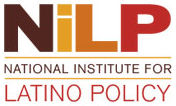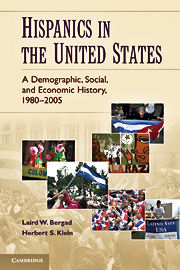 Hispanics in the United States:
Hispanics in the United States:
A Demographic, Social, and Economic History, 1980-2005
By Laird W. Bergad and Herbert S. Klein (Cambridge: Cambridge University Press, 2010)
REVIEWED BY ANGELO FALCON
 It was, ironically, around World Statistics Day, October 20th, that I received my copy of Bergad and Klein's massive Hispanics in the United States , a literal treasure cove of statistics on Latinos from 1980 to 2005. Its' 468 pages contain 130 tables, 124 black and white illustrations and 12 maps. Given my interest in the Census, World Statistics Day is a big event in my house and getting this volume bursting with so much data on that day had me, well, statistically drunk. This volume takes off where another 456-page tome on the subject, now a classic, The Hispanic Population of the United States (New York: Russell Sage Foundation, 1987), by Frank D. Bean and Marta Tienda, left off with the 1980 Census.
It was, ironically, around World Statistics Day, October 20th, that I received my copy of Bergad and Klein's massive Hispanics in the United States , a literal treasure cove of statistics on Latinos from 1980 to 2005. Its' 468 pages contain 130 tables, 124 black and white illustrations and 12 maps. Given my interest in the Census, World Statistics Day is a big event in my house and getting this volume bursting with so much data on that day had me, well, statistically drunk. This volume takes off where another 456-page tome on the subject, now a classic, The Hispanic Population of the United States (New York: Russell Sage Foundation, 1987), by Frank D. Bean and Marta Tienda, left off with the 1980 Census.
Bergad and Klein's volume is an ambitious collection of Census statistics from 1980 to 2005, and in some instances beyond, in which, they explain, "As historians we focus upon what to us is the essence of of history --- measuring change over time." They go on to point out that "... unlike most studies on Hispanics, which are statistically static in that they concentrate upon particular variables in specific years, this study presents and analyses statistical indicators of change over time."
The wide array of subjects they cover include immigration, population growth and dispersion, wealth and poverty, educational attainment, citizenship, the Latino electorate, voter participation, occupations structures, employment and unemployment, English language abilities and domestic usage, business ownership, race and marriage patterns. Most of the volume is descriptive with very modest analyses of these statistics. Bergad and Klein took Census statistics from the Public Use Microdata Samples (PUMS) of the 1980, 1990 and 2000 decennial counts and the 2005 one-year estimates from the American Community Survey (ACS) and created time series tables and graphs on these many subjects.
For those familiar with these statistics, this volume doesn't offer any new major insights, but is a handy reference guide to this mass of numbers. Familiar themes emerge, like the diversity of the Latino population, high indicators of economic distress, the geographic dispersion of the population, and so on. There are also some interesting comparisons of local Latino communities. There isn't, however, any real attempt to provide any overarching theories or trends, and many of the observations made are too overly qualified to make an impression.
This lack of using these statistics to inform a broader narrative on the Latino experience in the twenty-five years covered is disappointing. Their statement that the issue of "Latino identity" is one they "have chosen not consider in this book" is a bit puzzling, as is their failure to more systematically and statistically connect the data in the different subjects using multivariate and other more advanced statistical methods. This is especially the case given Klein's much more analytical and impressive recent book, A Population History of the United States (Cambridge: Cambridge University Press, 2004). Where one would expect this latest volume to build on this earlier one, there is hardly any connection between the two except in the most superficial sense. Reading Bergad and Klein's book brings to mind another historian's admonishment, namely, Carl C. Becker's point that "to suppose that the facts, once established in all their fullness, will 'speak for themselves' is an illision."
What relatively little analyses the Bergad and Klein volume present are largely descriptive and the larger points they make are also strangely disconnected from the statistics with which they jam their book. They make many assertions that are simply not supported by their data. A major assertion they make is that they have found that " ... the evolution of the Hispanic population differs very little in the most fundamental ways from earlier waves of migrants who arrived in the United States from its foundation in the late 18th century." (my emphasis) They go on to state that:
In its patterns of social, cultural, and political integration, language retention, economic and geographic mobility, class structures, multiple impacts upon popular culture, and even return migration, the experiences of Hispanics in the United States are similar to the classic patterns found in all immigrant communities of the 19th and 20th centuries. Only the forced migration of Africans from the 17th to the 19th century through the slave trade remains an anomaly in the history of migration and the evolution of domestic populations in the United States.
Although this is a well-articulated and sweeping position that has its fair share of adherents, it is not fully supported by the data and the analyses they present in this volume. Marshaling the same data one could argue just as well that Latinos are undergoing a process of negative and persistent racialization, internal colonialism, capitalist exploitation, or whatever. Their broad and optimistic generalization certainly doesn't easily square with many current realities and research on the subject. What, one might reasonably ask, is the purpose of presenting so much data only to in the end provide conclusions that are just based on the authors' opinions? Proof by association is not sufficient and can be quite misleading.
They also keep making the assertion that theirs' is the first study to provide a statistically comprehensive and dynamic look at the Latino experience. This is clearly not the case as Marta Tienda and Faith Mitchell's edited report, Hispanics and the Future of America (Washington, DC: The National Academies Press, 2006) is but one recent example, as well as Edna Acosta-Belén and Carlos E. Santiago's Puerto Ricans in the United States: A Contemporary Portrait (Boulder: Lynne Rienner Publishers, 2006), to name but two off the top of my head.
While they also point out that their goal was to present this information in ways that are accessible to the quantitatively-challenged, their approach to the material is a bit too convoluted and many of the tables too dense for this purpose. It is a difficult and dry read that could have benefited by a more creative approach to the presentation of the material. A good example of this, although not focused on Latinos, is William N. Frey and et al.'s America by the Numbers: A Field Guide to the U.S. Population (New York: The New Press, 2001).
There were also quite a number of methodological problems. There were a number of inconsistencies that were troubling. Although this book is presented as a compendium of Census data, they deviate from the Census Bureau's definition of Hispanics by including Brazilians and excluding those of Iberian origin. Why would they redefine the official definition in this way and not provide an explanation in all the tables in which they did this? They also explain that they used decennial Census data via the American Fact Finder tool on the Census website amd iPUMS that use the official definition of Hispanics. It is not clear when the data in the tables presented conform to the Census or to the Bergad-Klein definition. Confusing.
It was also disheartening to see that while Bergad and Klein took the time to include and exclude certain groups in their redefintion of the Hispanic category, they totally neglected to include Puerto Rico. They had no discussion of why they were excluding Puerto Rico when comparable data is available for this U.S. territory for the period they were covering.
Because they use different data sources, another problem is their failure to source any of their tables and graphs. Given their opening explanation that the book is using decennial and ACS statistics, the casual reader might assume that all the tables and graphs are from these sources. However, in the chapter on Hispanic businesses, that data is based on a different source, the Economic Census' Survey of Business Owners, but the reader of the tables and graphs wouldn't know that. But even more problematic is their lack of sourcing in their chapter on voting and registration because neither the decennial Censuses nor the American Community Survey ask about these things. These election data are collected every two years by another Census survey, the Current Population Survey (CPS). There is no reference in this chapter to the CPS at all, but rather, at one point, to the ACS.
The compiling and construction of this time series data set was certainly a major and laudable undetrtaking by the authors. There is a great need for the analysis of these types of data, especially as we begin to get the results of the 2010 Census and the first 5-year estimates of the American Community Survey starting this December. Although there is enough useful information here to merit having a copy of this volume in your library, Bergad and Klein's Hispanics in the United States is, however, in need of much more work for it to become the indispensible reference guide that it could potentially be.
Angelo Falcón is President of the National Institute for Latino Policy (NiLP). He chairs both the Census Advisory Committee on the Hispanic Population and the Steering Committee of the Census Bureau's Census Information Centers (CIC) Program.
